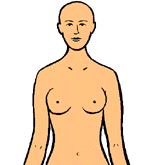|
 Breast Implants: The Surgery Breast Implants: The Surgery
Who Qualifies
Women undergo breast augmentation surgery for a variety of
reasons:
- A desire to correct a reduction in breast volume after pregnancy (actually this is a reduction to normal size).
- Reconstruction after breast surgery.
- To balance a difference in breast size (lop-sidedness).
- To enhance breast size for women who feel their breasts are too small.
Surgeons can generally increase bust size by about one or two
cup sizes.
The Procedure
There are several different methods in use for the actual surgical
procedure of placing breast implants into the breast. The method
that your surgeon will use depends on your anatomy and your
surgeon's recommendation. There are three types of incisions that
can be made, either in the armpit, around the areola (the dark skin
surrounding the nipple), or underneath the breast in the crease
where the breast meets the chest.
Once the incision is made, the surgeon will lift the breast tissue to
create a pocket to place the implant into. The pocket can be made
either directly behind the breast tissue or underneath the muscle of
the chest wall. The implants will be centered behind the nipples.
The entire procedure usually takes about one to two hours. Some
surgeons think that putting the implant behind the musculature of
the chest will reduce the chance of capsular contracture
(hardening) and may improve breast examination by
mammogram. Capsular contracture is the development of a layer
of scar-like tissue around the breast implant. This occurs because
the body recognizes the implant as a foreign object.
Recovery
Although you will feel worn out and sore for a few days after the
surgery, you should be up and around within about 24 to 48 hours.
The stitches on the incisions will be removed in about a week to 10
days after the surgery. However, breast swelling may last as long
as three to five weeks and you may experience a burning
sensation in your nipples for two weeks. This sensation should
subside as the bruising heals. Within a few days after the surgery,
the gauze bandages covering the incisions will be removed and
your doctor may give you a surgical bra to wear that will give you
extra support while you heal. Your doctor will provide you with pain
medication to control your discomfort.
Costs
The cost of a double breast enhancement surgery (i.e., both
breasts get implants) runs about $3000, but this figure will vary by
location and surgeon. Insurance agencies usually do not cover
breast augmentation surgery, although sometimes
post-mastectomy reconstruction is covered. Therefore, if you are
undergoing augmentation surgery, you will be required to foot the
entire bill. Many plastic surgeons have payment plans. And no, they
won't re-pocess your breasts if you fall behind.
There may be other costs associated with breast implants. These
costs are not monetary, they are health costs. There is some
evidence that breast implants may cause or contribute to a variety
of health disorders in women. Keep this in mind when considering
implants.
|





















 Breast Implants: The Surgery
Breast Implants: The Surgery